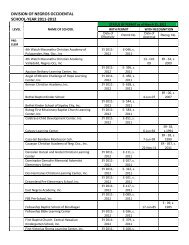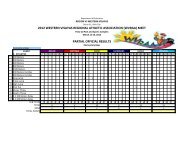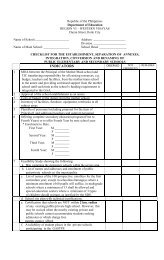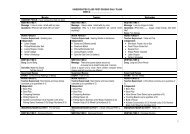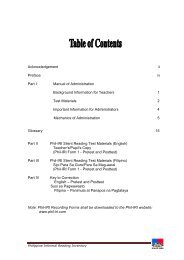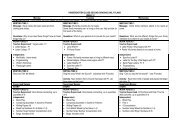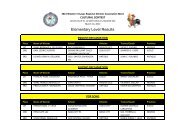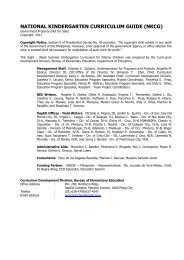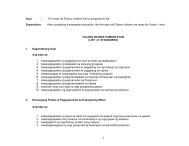5s 6s AM Class Fourth Quarter Daily Plans (sample)
5s 6s AM Class Fourth Quarter Daily Plans (sample)
5s 6s AM Class Fourth Quarter Daily Plans (sample)
Create successful ePaper yourself
Turn your PDF publications into a flip-book with our unique Google optimized e-Paper software.
WORK PERIOD 2: WORK PERIOD 2:Teacher-Supervised: Hand game (up to quantities of 5;writing number sentences)Teacher-Supervised: Lift the bowl (up to quantities of 5; writingnumber sentences)Independent: Block Play Counting Boards (quantities of 5) Subtraction Cards (2-5) Bingo: Addition/ Bingo: Subtraction (0-5) Go 5/ Draw 5/ Find 5/ 5 Concentration Writing Numerals (0, 1, 2, 3, 4, 5)Independent: Block Play Counting Boards (quantities of 5) Subtraction Cards (2-5) Bingo: Addition/ Bingo: Subtraction (0-5) Go 5/ Draw 5/ Find 5/ 5 Concentration Don’t Rock the BoatRHYMES/POEMS/SONGSRHYMES/POEMS/SONGS Everybody Do This MakapaglaroINDOOR/OUTDOOR ACTIVITY: Count And TurnINDOOR/OUTDOOR ACTIVITY: One Potato (Fun with FriendsMEETING TIME 3: Dismissal RoutineMEETING TIME 3: Dismissal Routine
APPENDIX: WEEK 16A. THEME-RELATED ACTIVITIESSMALL GROUP ACTIVITIESA. THEME-RELATED ACTIVITIESPOSTER: ISANG MUNDONG MAKABATALayunin/ Kasanayan: maipahayag ang mga karapatan ng bataMga kagamitan : kartolina/manila paper lapis, papel ,pandikit, krayolaBilang ng Gagawa : bawat bataPamamaraan:1. Pag-uusapan ng klase ang mga sumusunod:a. Mga bagay na dapat nagagawa ng isang batab. Mga bagay na dapat mayroon ang isang bata upang mabuhay nang maayos2. Ipapaliwanag ng guro sa mga mag-aaral ang gawain.3. Ipapaskil ng guro ang kartolina o manila paper na may pamagat na ISANG MUNDONG MAKABATA sapisara.4. Sa isang bond paper o papel, iguguhit ng mga mag-aaral ang mga bagay na dapat nagagawa ng isang bata atmga bagay na dapat mayroon ang isang bata upang mabuhay nang m5. Kukulayan ng mga mag-aaral ang kanilang iginuhit.6. Ididikit ng mga mag-aaral ang kanilang “master piece” sa kartolina o manila paper na nakapaskil sa pisara.7. Pag-uusapan ang kanilang ginawa.CHILDREN’S RIGHTS MOBILEObjective: demonstrate awareness of children’s rightsMaterials: hanger, string or yarn, shape boards(covered with construction paper), colored markers or crayonsProcedure:1. Ask children to draw what they think children must be able to do and what they would needto grow and develop.2. Have them draw on each shape board. Attach a string on it.3. Let them tie their shape boards on the hanger.MINI-BOOK: WHO HELPS ME ?Objective: identify people who help address his needsMaterials: shape book ( person ), colored markers or crayonsNumber of participants: 8-10 childrenProcedure:1. Distribute a shape book to each child.2. Have him draw the different people who help provide for his needs e.g. family members, people in school and thecommunity.CHILDREN’S GALLERY: WHAT WE LIKE TO DOMaterials: shape book ( person ), colored markers or crayonsNumber of participants: 8-10 childrenProcedure:Distribute different shape cut-outs. Have children draw different things children like to do or have.TSART: GUSTO KO, AYAW KOLayunin/Kasanayan : Identify the rights of a child’Mga kagamitan: kartolina/ manila paper, lapis,papel/bond paper, krayola, pandikitBilang ng Gagawa : bawat bataPamamaraan:1. Pag-uusapan ng mga mag-aaral ang kanilang gusto at hindi gusto sa kanilang komyunidad.(Halimbawa: Gusto – palaruan ; Hindi Gusto – taong nananakit2. Ipapaliwanag ng guro sa mga mag-aaral ang gawain.3. Ipapaskil ng guro ang kartolina o manila paper na may pamagat na “GUSTO KO, HINDI KO GUSTO” sa pisara.
4. Sa isang bond paper o papel, iguguhit ng mga mag-aaral ang kanilang gusto at hindi gusto sa kanilang komyunidad5. Gamit ang krayola, kukulayan ng mag mag-aaral ang kanilang iginuhit.6. Idididkit ng mga mag-aaral ang kanilang “master piece” sa kartolina o manila paper na nakapaskil sa pisara.7. Pag-uusapan ang kanilang ginawa.Family AlbumMga Kagamitan: bond paper/papel (limang piraso)lapiskrayolapandikitPamamaraan:1. Pag-uusapan sa klase : “ Anu-ano ang mga bagay na nagagawa ng inyong mga pamilya para sa inyo?”.2. Ipapaliwanag ng guro sa mga mag-aaral ang Gawain.3. Gamit ang limang papel at lapis, guguhit ang mga mag-aaral ng limang bagay na ginagawa ng kanilang pamilya para sakanila. (isang bagay bawat papel)4. Kukulayan ng mga mag-aaral ang kanilang iginuhit.5. Gamit ang pandikit, didikitan ang kaliwang gilid ng mga papel para magmukhang aklat.6. Ipapasa ng mag-aaral sa guro ang kanyang ginawa.7. Pag-uusapan ang ginawa.DRAWING: SI_____(TATAY) AT AKOLayunin/Kasanayan : Identify the rights of a childMga Kagamitan : papel/bond paper, lapis, krayolaBilang ng Gagawa: bawat bataPamamaraan:1. Pag-uusapan ng klase kung sinu-sino ang mga kasapi ng pamilya.2. Tatanungin ng guro sa mga mag-aaral kung ano ang naitulong ng bawat kasapi ng pamilya sa kanila.3. Papipiliin ng guro ang bawat mag-aaral ng isang kasapi ng pamilya na may naitulong sa kanya.4. Gamit ang papel at lapis, iguguhit ng mag-aaral ang napili nyang kasapi ng pamilya pati ang naitulong sa kanya.(Halimbawa : Tinuruan ako ni Nanay na magpunas ng mesa. Iguguhit ng mag-aaral si Nanay at ang sarili nyangnagpupunas ng mesa).5. Gamit ang krayola, kukulayan ng mag-aaral ang kanyang ginawa.6. Ang pamagat ng kanilang ginawa ay ayon sa napiling kasapi ng pamilya ( Si Nanay at Ako)7. Ipapasa ng mag-aaral sa guro ang kanyang ginawa.8. Pag-usapan ang ginawa.Mobile: Mga Taong Tumutulong sa AkinLayunin/Kasanayan : makilala ang mga taong tumutulong sa atin sa komunidadMga Kagamitan : papel/bond paper, lapis, krayolaPamamaraan:1. Gumuhit ng mga taong tumutulong sa ating komunidad.2. Idikit ito sa folder o cardboard.3. Lagyan ng tali sa dulo.4. Isabit ito sa isang bahagi ng classroom.5. Lagyan ng pamagat “ Ang mga Taong Tumutulong sa Ating KomunidadNote: The stories for this week revolve around children’s rights. Use these stories to reinforce their understandingabout rights. Encourage them to make personal connections with these stories.
B. OTHER MATH ACTIVITIESBlock PlayObjective: to explore the attributes of 3-dimensional or space figuresto understand the relationship between figuresto build structures using blocksMaterials: table or floor blocksNo. of Participants: 1-4Procedure:Children use table or floor blocks to build structures.While building structures children are encouraged to talk about attributes of block (e.g. long/ short, heavy/light) and therelationship of each block to another (e.g. 2 of these blocks make 1 of these blocks)Children can also be encouraged to build structures based on the theme of the week (e.g. building homes, schools,establishments in the community)Playdough Numerals (0-5)Objective/Competency: To identify the numerals 0, 1, 2, 3, 4 and 5Materials: playdoughNumber of Players/Participants: 6 childrenProcedure:1. Give each child a medium-sized ball of playdough.2. Let them to form the numerals 0, 1, 2, 3, 4 and 5.3. Then ask each child to create the number of objects for each numeral. (Example: 2 hearts – numeral 2)Writing Numerals (0,1, 2, 3, 4, 5)Objective: to write numeralsMaterials: lined paper (blue-red-blue lines) numeral cardsPreparation: Draw the numerals on a piece of card board. The first part of the numeral is drawn with the purple crayonand the second part with green. The purple and green marks will help children determine which stroke to do first.1. Provide each child with numeral cards and lined paper.2. Let each child practice writing the numerals on lined paper.It’s A MatchObjectives: to match numeral to set of objects/ dotsPlayers: pairs or small groupMaterials: one set of cards with numerals – 0 -4one set of cards with dots (corresponding to the numerals)Procedure:1. Place the numeral cards face down in a box.2. Place the corresponding dot pattern cards in the chalk tray.3. Call on a child to get a card form the box and place it over the equivalent card in the chalk tray.4. If correct, the child may choose the next playerMixed Up NumbersObjectives: To read and recognize number wordsTo recognize the sequence of numbersPlayers:small groupMaterials: vocabulary cards of number words (1-4)Procedure:1. Place the word cards at random in the chalk tray.2. Ask the students to say each word with you.3. Ask the children to help you place them in correct sequence.4. Tell the children to hide their eyes while a mischievous kitten (you) comes and change the order of the cards.5. The children close their eyes and lower their heads on their desk.6. The teacher switches cards and then calls on a pupil to return them to the correct places.Variation: Distribute the cards to the children. Call one of the word names. A student with the corresponding card is invitedto stand. “Neighbors” – those whose numbers are one less or one more than this student’s – are then invited to join in.
Continue until all are standing in the appropriate number.Draw 5Objective : to explore different combinations that make 5Materials : 4 sets of numeral cards (0 –5)No. of players / participants: 3- 5 playersProcedure1. One card is drawn from the deck and is set aside throughout the game, so that there will be an odd card without a mateat the end of the game. All the other cards are dealt.2. Each player goes through the cards received trying to find pairs that make 5. All the pairs thus made are discarded inthe middle of the table.3. The players then take turns, each holding her cards like a fan and letting the person to her left draw one of them withoutlooking at them. If the person who draws the card can use it to make 5 with one of the cards in her hand, she discardsthe pair in the middle of the table. If she cannot use it, she has to keep it. She then holds all her cards like a fan so thatthe person to her left can draw one of them by chance.4. Play continues until one person is left holding the odd card and loses the game.5 ConcentrationObjective: to explore different combinations that make 5Materials: 4 sets of numeral cards (0-5)Procedure:1. Sixteen cards are placed in the middle of the table, face down, in a 4 x 4 arrangement. The remaining cards are placedfaced-down in a stack.2. The players take turns turning over two cards, trying to turn a pair that totals 5. If a pair can be made, the player keeps itand continues to play as long as he is successful. If he is not successful, he returns the two cards to their original facedownpositions and replaces any cards he took with new ones from the deck.3. With 16 face-down cards on the table, the turn passes to the next player to the left.4. The person who collects the greatest number of pairs is the winner.Find 5Objective / Competency: collect pairs of cardsMaterials : 4 sets of numeral cards (0-5)No. of players / participants : 3-5 playersProcedure1. All cards are dealt. Last card is turned face up. Each player keeps the cards dealt to him in a stack, face-down, withoutlooking at them.2. By turns, players turn over the top card of his stack. If this card can be used with one on the table to make a total of 5,the player can take it and keep the pair. If there are no cards that can be used, he has to discard his card in the middleof the table, face up.3. The player who collects the most number of pairs wins.Go 5Objective: to explore different combinations that make 5Materials: 4 sets of numeral cards (0-5)Procedure:1. All the cards are dealt.2. The players take turns asking specific people for specific cards in a way similar to the card game Go Fish. Forexample, John may say to Carol do you have a 1 ?" If Carol has a 1, she has to give it up to John. John then lays this1 and a 4 in front of himself, face up.A player can continue asking for a card as long as he gets the card he requested. If he does not get the card he askedfor, the turn passes to the person who said, "I don't have it."3. The person who makes the greatest number of pairs is the winner.Subtraction CardsObjective: to subtract quantities up to 5Materials: subtraction cards, countersNo. of Participants: 1-4Procedure:1. Teacher reads the total on the card, in this case 5.2. Children get 5 counters.3. Teacher says "take away one" while lifting the right hand flip.
4. Children take away 1 counter, count remaining counters and say "four"5. Teacher shows the group the four remaining dots on the subtraction card.Bingo: Addition (up to quantities of 5)Objective: To match an addition fact with its correct sumMaterials: bingo card for each player calling cards tokensNo. of Participants: 1-4Procedure:1. Provide each player with a bingo card.2. Assign a student to call out what is written on calling cards.3. First one to cover all spaces wins. If players go through all the cards without reaching Bingo, they should reshuffle thecards, then turn them face down again and continue playing until someone has won.Bingo: Subtraction (up to quantities of 5)Objective: To practice subtraction up to quantities of 3Materials: bingo card for each player calling cards tokensNo. of Participants: 1-4Procedure:1. Provide each player with a bingo card.2. Assign a student to call out what is written on calling cards.3. First one to cover all spaces wins. If players go through all the cards without reaching Bingo, they should reshuffle thecards, then turn them face down again and continue playing until someone has won. Counting Boards (concrete, up to quantities of 5)Objective: to explore different combinations that make a given quantityMaterials: counting boards & counters (example: webs & spiders, rivers & fish, stores &hats, tables & chairs, sinks & plates)Procedure:1. Give each child one counting board.2. Have the children take the number of counters being worked with for the day and decide what they want to represent.3. Take turns in telling a story to go with the counters.Ex: Three fish were swimming. Three more came. That makes six fish swimming.I saw seven mangoes in the tree. I climbed the tree and got two mangoes. Five mangoes were left.Lift The Bowl (connecting, up to quantities of 5)Objective: to explore different combinations that make a given quantityMaterials: bowl or cup, any kind of counter such as pebbles, chips, or sticksNo. of Participants: small groupProcedure:Game proceeds as Hand Game but bowls are used for separating quantities.Teacher says: Children say: Teacher places these cards on theLift the Bowl counting board"Place five blocks under the"None and five is five." orbowl.""Zero and five is five."05"Place one block on the bowl.""One and four is three."14
"Place two blocks on the bowl.""Two and three is five."23"Place three blocks on thebowl.""Three and two is five."32"Place four blocks on the bowl.""Four and one is five."41"Place five blocks on the bowl.""Five and none is five." or"Five and zero is five."50Hand Game (symbolic, up to quantities of 5)Objective: to explore different combinations that makes a given quantityMaterials: any kind of counter such as pebbles, chips, or sticks numeral cards work matsNumber of Players/Participants: 8 childrenProcedure: Children work in small groups. Teacher gives each child a given quantity of sticks, for example 3. Children separate counters in different ways and verbalize the combinations that result. Children write a number sentence to represent number combinations.Teacher says: Children say: Children write:"Place five sticks in your right hand.""None and five is five." or"Zero and five is five." 0 + 5 = 5"Place one stick in your left hand.""Place one more stick in your left hand.""Place one more stick in your left hand.""Place one more stick in your left hand.""Place one more stick in your left hand.""One and four is five."1 + 4 = 5"Two and three is five."2 + 3 = 5"Three and two is five."3 + 2 = 5"Four and one is five."4 + 1 = 5"Five and none is five." or"Five and zero is five." 5 + 0 = 5After 1 round children can be introduced to the word PLUS. “Instead of using the word AND I’d like you to use the wordPLUS instead. PLUS means to put two groups of objects together.”Lift The Bowl (symbolic; up to quantities of 3)Objective: to explore different combinations that makes a given quantityMaterials: bowl or cup, or any kind of counter such as pebbles, chips, or sticksNumber of Players/Participants: 8 childrenProcedure:1. Game proceeds as Hand Game but bowls are used for separating quantities.
2. Children write a number sentence to represent number combinations.Teacher says: Children say: Children write:"Place five blocks under the bowl.""None and five is five." or"Zero and five is five."0+55"Place four blocks under the bowl." "One and four is three." 1+45"Place three blocks under the bowl." "Two and three is five." 2+35"Place two blocks under the bowl." "Three and two is five." 3+25"Place one block under the bowl." "Four and one is five." 4+1"Place no blocks under the bowl.""Five and none is five." or "Fiveand zero is five."5+05After 1 round children can be introduced to the word PLUS. “Instead of using the word AND I’d like you to use the wordPLUS instead. PLUS means to put two groups of objects together.”Hand Game – WorksheetObjective: to write addition equations involving quantities of 4To conserve numberMaterials: counters Hand game work mat Hand game worksheet pencilProcedure: Instruct children to play the Hand game as before. Tell them to record or write equations that represent their concrete manipulations on the Hand game worksheetIf worksheets are not available, teacher can simply write the combinations0 + 5 = ____ 1 + 4 = _____ 2 + 3 = ____ 3 + 2 = _____ 4 + 1 = _____ 5 + 0 = _____5 – 0 = ____ 5 – 1 = _____ 5 – 2 = _____ 5 – 3 = _____ 5 – 4 = _____ 5 – 5 = _____Lift the Bowl - WorksheetObjective: to write addition equations involving quantities of 4To conserve numberMaterials: counters Lift the Bowl work mat Lift the Bowl worksheet pencilProcedure: Instruct children to play the Lift the Bowl activity as before. Tell them to record or write equations that represent their concrete manipulations on the Lift the Bowl worksheet.If worksheets are not available, teacher can simply write the combinations in the following vertical position
0+55 51+45 42+35 33+25 24+15 15+05 0Don’t Rock the BoatMaterials: playing board, counters, diceProcedure:1. Players roll the dice to travel back and forth inside the "boat".2. The player who lands in the center with an exact roll is the winner.Variation: For a solitaire, place markers on all the twelve outer spaces. Each time the player lands on a space, he or shecollects the marker. The object is to collect as many markers as possible before landing in the center.C. OTHER LANGUAGE ARTS ACTIVITIESLetter Fishing GameObjective: to identify upper case lettersMaterials: fishing hook, 24 letter cardsNumber of players/participant: 5-6Procedure:1. Arrange the chairs in a circle.2. Place the letter fish cards inside the circle.3. Ask players to sit on each chair.4. Each player takes turns fishing a card.5. Ask the child to identify the letter that he fishes out.6. Ask everyone from the group to sound out the letter.7. Invite the children to think of 2-3 words that begin with that letter.8. At the end of the game, ask children to count the number of fishes that they caught.Variation: After the game, children can be asked to copy the letters that they caught on a piece of paper or draw thingsthat begin with that letter.Sound RollObjective: letter-sound associationMaterials: Ball Picture card necklacesNumber of Players: 6Procedure: Gather the children and let them sit in a circle. Give each child a picture card necklace.
Roll the ball to one childThat child rolls the ball to another child whose picture card begins with the same letter as his picture card.Variation: This can be done for final sounds, or medial sounds or rhyming words as well.See previous appendices for the following activities: Letter Mosaic Letter Collage Letter Poster: Pictures/Drawings of objects that begin with Ii/ Cc Let’s Write Words Poster Playdough: Form a LetterLetter Memory GameObjective: to identify upper case lettersMaterial : 6 pairs of upper case lettersNumber of players/participant: 5-6Procedure:1. Place all cards on the table face down.2. Each player turns over two cards during his turn. If he gets a pair of identical letter cards, he gets to keep the pair andtakes another turn.3. If the letter cards do not match, the player puts back the cards into their original places.4. The player who is able to get the most number of pairs wins the game.Shape DominoObjective: recognize geometric shapesMaterial : shape domino cardsNumber of players/participant: 4-5Procedure:1. Deal all cards to the players.2. The first player lays down a card.3. The next player lays down a card that can be connected to either shape on the card. Game continues until all cardshave been laid down or until none of the cards left could be connected to either endStory BannerObjective: identify story detailsMaterials: manila paperNumber of players/participants: 4-6Procedure:1. Pre-cut the manila paper in the shape of a banner.2. Ask children to recall details of the story just read. e.g. characters, setting, major events, title3. Write the title at the top or center of the manila paper.4. Each child draws a story detail in a separate paper (construction or bond paper).5. He/She cuts this out and paste this on the story banner.Story StripsObjectives: identify story eventsMaterials: manila paper folded in 6 parts lengthwise, marker, crayons, bond paper/newsprintNumber of players/participants: 4-6Procedure:1. Discuss the story just read.2. Have children recall story events and have them draw this on strips of paper.3. Have them paste this on the manila paper.4. Display the story strip poster.D. SONGS/POEMS/ RHYMES Sampung Mga Karapatan (song) Edukasyon aking karapatan (PEHT p. 140) Rhyme: I had a Little Brother
E. INDOOR/OUTDOOR G<strong>AM</strong>ESSave Yourself (PEHT p. 227)One Potato (PEHT p. 231)Touch ColorAsk the children to touch a specific number of items of a certain color with a particular body part. For example, you might call out:“Touch three red things with one knee.” The children will now look for red items and then seek to apply their knees to the items.Blend HomerunMaterials: chalkProcedure: Mark four corners of your game area as your bases with chalk or anything that the players can easily see e.g. plants in potsor sand bags. Divide the group into two teams. For each turn: Say aloud a word in parts, such as /s/ /a/ /t/. If the can blend the word, he or she can go to the first base. Eachplayer will get three tries before he or she strikes out of the team’s turn. When the second player takes his or her turn and runs to the first base, the child on the first base will move to the secondbase. He or she will move to the next base as new runners take a base. The team gets a homerun (or a score) when a playerhas gone to all the four bases. Each team’s turn will end when three of its players are out. Then the other team can take their turn.Variation: Allow the members of the other team to think and say aloud words in parts for the other team to blend.Count And TurnObjectives:to count in sequenceTo develop body coordinationTo develop a sense of rhythmTo learn one-to-one correspondenceMaterials: nonePlayers: whole or small groupProcedure:The children stomp their feet as they count, throwing their arms up in the air to emphasize the last number in the sequence. Thechildren change directions without losing the beat, counting “one” as they turn..One, two, three, four, fiiiiive(turn) one, two, three, four, fiiiiive(turn) one, two, three, four, fiiiive….



